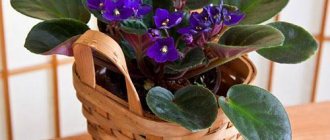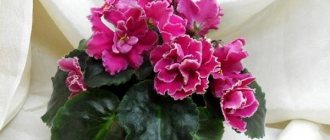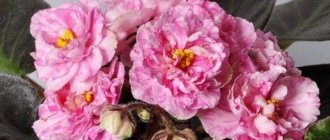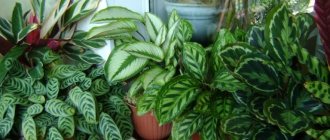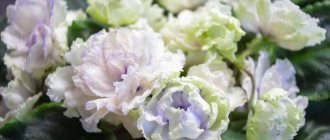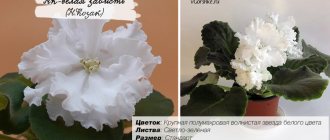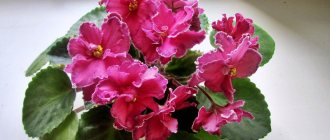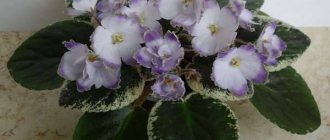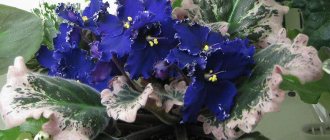Appearing on the territory of the USSR only in 1960, the Usambara violet or Saintpaulia quickly gained incredible popularity among lovers of indoor plants.
Over time, flower growers were no longer content with violets with simple blue or purple flowers, but excitedly exchanged leaves and children of varieties that delighted with inflorescences of various shades and shapes. Today, varietal Uzambara violets, based on the shape of the flowers, their color, type and size of the rosette, are divided into many groups worthy of consideration and study. After all, just the names of varieties of violets and their photos make the hearts of connoisseurs of living beauty beat faster.
Violet Black Pearl
The double flowers of the Black Pearl violet, obtained by the famous breeder E. Korshunova, are distinguished by their extraordinary size and thick purple-violet color with a noble velvety tint. A single flower at the stage of full dissolution can reach 7 cm in diameter, while the plant forms an inflorescence-cap consisting of 6–8 corollas. The standard-sized rosette consists of simple dark green leaves, against which dense pom-poms of flowers look even more solemn.
Humidity and watering
Increased temperature in the apartment when growing violets leads to dry air and soil, which has a detrimental effect on the plants. To maintain normal humidity, spray near the flower from time to time or place a container of water filled with pebbles. Watering is carried out as the soil dries, only warm water is used. A sufficient amount of water for the plant's root system guarantees its health and active growth.
During the growth period (all spring and summer), the violet’s need for water increases. It is necessary to water the plant when the top layer of soil dries out by 1.5 cm. In this case, Saintpaulia will never experience stagnation of water, which adversely affects the condition of the plant.
Violet Wedding bouquet
Photo of violets A wedding bouquet in full bloom evokes involuntary admiration among many amateur gardeners. Indeed, having seen a plant only once, you cannot refuse the desire to see this miracle on your windowsill. The variety obtained by Konstantin Morev forms a rosette of standard sizes. The leaves are simple, pubescent, and have a beautiful green hue. The flowers are semi-double or simple, extremely large. The flowers are given a special airiness by a bluish shadow at the base and a wide corrugated edge. The inflorescence leaves the feeling of a bouquet worthy of a bride.
Other original varieties
“Well done Yegorka”
This variety was developed by Evgeny Arkhipov in 2013. A beautiful violet that has standard sizes . Violet with large single and semi-double star-shaped white flowers, which are covered with purple spots interspersed with pink. The foliage is light green.
The brightness of the petals will depend on the lighting. The brighter it is, the more noticeable the flowers become. The plant loves natural light. The best place would be a window sill with windows facing west or east. And don’t forget that violet doesn’t like direct sunlight, so it needs to be shaded. If the side is north, then in autumn and winter additional lighting will be required, which can be organized using special lamps.
To avoid hypothermia of the roots during frosts, you need to maintain the temperature in the room with the flower around +18..+20 degrees. also need to monitor the humidity in the container and do not overwater the plant . There should be a break between waterings, the soil needs to dry out. Excessive moisture can lead to fungal diseases and death of the violet. Watering should be done carefully; this should be done in a tray or along the edge of the pot.
Advice : Experienced flower growers recommend not using plastic containers for violets. Can be planted in ceramic pots.
"Aquarius"
The variety was developed back in 2012. The flowers are saucer-shaped and arranged tightly to each other. They are large, round and wide open. Shade of blue, blue with a purple tint. White and pink peas are randomly scattered on the flowers themselves. Flowers can grow up to 5-6 centimeters. The leaves are deep green in color and have short petioles.
Violet loves warmth, like the previous variety, so when choosing a location you need to take this feature into account. Humidification occurs only through a tray into which water is poured. Planting is carried out only in a ceramic container. Plastic pots can cause flowers to die. Fertilizing occurs by adding fertilizer to water, which is poured into the pan.
The plant got its name not only because it has this color of petals, but also because of its love for water. Often violets do not like it when liquid gets on their leaves, flowers, stems, but this variety is not one of those. If moisture is supplied in sufficient quantities, “Aquarius” becomes brighter in color.
Violet Red River
Ampel Saintpaulia or Uzambara violet, bred by N. Andreeva, blooms in abundance with 3-centimeter semi-double flowers of an unusual red hue for the culture. According to the author's description, the flowering of the Red River violet will be more intense and vibrant if the plant is located in a well-lit place.
Closer to wilting, the corollas acquire a lilac or crimson color. A characteristic feature of the variety is active growth and unusual foliage color. On the green background, and especially along the edge of the leaf rosette, golden touches are clearly visible.
Reproduction
Violets are very unpretentious; they are propagated by leaf cuttings. The best time for rooting leaves is early spring and summer. Each healthy Saintpaulia leaf is a mature organ and is capable of creating its own roots, which will serve as the beginning of new plants that repeat the parental properties. To root leaves, use water, substrate, humus tablet or moss. The leaves take root most quickly in the soil.
Tristan violet cuttings, described below, are planted in small plastic pots and covered with a plastic bag on top until the babies appear. The resulting greenhouses are periodically ventilated. Grown-up children are transplanted into prepared soil.
Violet Rosie Ruffles
The Rosie Ruffles violet, bred by D. Harrington, is a standard sized rosette consisting of pubescent green leaves with a wavy shape. The main advantage of the variety is its large star-shaped flowers. The color of the flowers is a light fuchsia shade. The edge is densely corrugated, lace.
Often gardeners are faced with the fact that children and rooted tops of rosettes do not retain the wavy edge of the petals inherent in the variety, and the decorative effect does not return as Saintpaulia grows. But when you place Rosie Ruffles violet plants on a cool windowsill, you can get a bright green border on the flowers.
Care techniques in the home microclimate
In the microclimate of indoor collections, the violet is distinguished by its very unpretentious behavior - the plant responds to the regular and careful implementation of agrotechnical practices typical for the genus by harmonious, measured development and the formation of luxurious bouquets of flowering:
- the plant likes to grow on windows facing west or east , where a suitable balance of volume and intensity of lighting is maintained: windows in the north direction should be equipped with an additional illumination system with diffuse spectrum rays;
- on southern windowsills, violets will need a light curtain in the summer heat.
- watering - dosed. Strict control over the condition of the upper part of the substrate is required - at each stage of watering, the soil in it must have time to dry out;
- to apply mineral fertilizing too often - the violet itself can indicate the need for this procedure with its appearance;
- proper lighting makes it possible for the harmonious development of violets - the tropical beauty needs diffused rays of daylight when exposed to them for a sufficiently long time;
- the temperature gradient should be maintained at +20 + 24°C. Do not expose the violet to sudden changes in temperature and drafts;
- when creating comfort, it is necessary to provide the violet with rich nutrition through fresh, aerated and permeable soil with sufficiently reliable drainage;
- At the time of transplantation, it is better to use the transshipment technique - it is less painful for the violet. But this method is not suitable if it is necessary to completely examine the roots of a diseased plant.
Violet Lituanica
The delicate pink flowers of the Lituanica violet will not leave any lover of this indoor plant indifferent. The variety selected by Butene forms a standard rosette of pointed, medium-sized leaves of an even, green color.
Due to their elongated petals, double flowers resemble dahlias in shape, and the corollas are made more unusual by the richer color of the tips of the petals. A very beautiful plant, named Lituanica in honor of the plane that took part in the flight from America to Kaunas in 1933. Lituanica violet blooms profusely, but grows rather slowly as the rosette matures.
Violet Tristan: photo and description of the variety
Tristan is one of the varieties of indoor violets that has an unusual and delightful appearance. Many gardeners manage to successfully grow this variety. The plant has white flowers with edges of a corrugated structure, on which there are strokes of purple and hot pink. Small socket. The flower looks great, you can hardly take your eyes off it. Leaves with slightly wavy edges of a light shade. Their surface can be semi-double or regular structure. To maintain a violet in a constant blooming state, as mentioned earlier, it needs bright light, a constant temperature of at least 18 degrees, normal air humidity, proper watering and timely replanting twice a year.
Violet Bullfight
Violet Bullfight from breeder E. Korshunova is a bright decoration in the collection of both a beginner who is fond of Saintpaulia and an expert in this culture. The rich shade of incredibly large, up to 8 cm in diameter, flowers of this variety and their unique, crimson coloring invariably attracts attention and distinguishes the plant from a number of equally worthy ones.
The flowers are semi-double, with a notch in the center of the corolla. With not very abundant flowering, due to the size of the flowers, there is no feeling of “predominance of foliage.” At the same time, on a bullfighting violet bush there can be from 3 to 5 flowers, and the newly opened ones are not inferior in size to the previous specimens. Under the weight of flowers and buds, flower stalks can lie on light leaves with a pointed tip.
Photo report from the spring exhibition at the Moscow House of Violets. Part II.
I continue reporting from the exhibition. Ivan Rachkov brought an interesting collection of chimeras. There were also many miniatures presented by Rita Nesterova, Marina Karpova, Igor Milekhin, Irina Shchedrina, Nina Starostenko, Lena Lebetskaya. Among the miniatures were interesting new items by N. Berdnikova and A. Kuznetsov. Lebetskaya brought her new seedlings, which will receive new names in the future.
I'll start the show with the chimeras of Ivan Rachkov. There were so many people at Ivan’s shelves that, unfortunately, I was not able to properly examine and photograph all his chimeras. But something happened. A few general plans:
"Princess Cherry":
And this is the leaf chimera Hermony Little Stincer (Harmony's):
Here is a bouquet from Hakata Doll:
Rainbow's Crystal Riot - delicate light blue flowers simply glow on a dark rosette:
As I understand it, the next photo is a chimeric sport from the Peace Maker variety.
Here is the original description of the variety: Peace Maker (D. Croteau) Semidouble dark blue star/pink fantasy, thin raspberry edge. Dark green, plain, quilted. Standard
“Dark blue semi-double wavy stars with reverse fantasy pink and a thin crimson edge. Symmetrical dark green plain and quilted foliage."
And in the photo there is a chimera violet with the same name. We will assume that this is a sport, although the owner of the collection did not indicate this in the title...
And this is the trailer for Rob's Miriwinnie. His fantasy specks merge into stripes, almost like chimeras:
And a couple more chimeras:
And, just the Royal Chimera Polar Star. Unfortunately, due to the complexity of shooting, the photo does not convey all the beauty and originality of this chimera. Flowers-stars of an interesting notched shape of a deep velvety dark red (almost burgundy) color with a light stripe in the center-fold of the petals and a beautiful ruffled frill along the edge of the petal. Flowers on strong peduncles. Very abundant flowering. Beautiful bouquet!
Now let's admire the miniatures. I would like to start the show with N. Berdnikova’s new product - N-Kaprisulya:
I really liked this miniature. And a variegated rosette, and large two-color and quite bright flowers, and a ruffle with a light green border - this baby has it all. I asked Rita about the character of this whim - does it correspond to the name of the violet? But Rita was pleased - the violet is not capricious.
There were a lot of varieties of Nadezhda Berdnikova at this exhibition:
And miniatures of other breeders:
Allegro Pink Pistachio is a fairly new variety. Until recently, it was difficult to buy a plant of this variety at an exhibition, and the price of a cutting reached 200 rubles! Now this variety is already in many collections. He takes part in almost every exhibition. But that didn't make him any less attractive. Lena Lebetskaya's rosette is very good!
And this rosette, as soon as I had time to photograph it, was taken by the new owner.
Miniatures by Igor Milekhin and Irina Shchedrin:
LE-Pyshechka is a very recent novelty by Lena Lebetskaya. Very original and delicate flowers.
And here are two variants of the CM-Golden Fish variety:
I've been looking for Rob's Seduction for a long time. This variety is rarely shown at exhibitions. This time I was lucky. Now I care and cherish the leaf.
Nearby there was a shelf with streps:
And these are containers with children. They were brought by Svetlana Repkina. It was very nice to see her again in the Moscow DF. What a courageous woman she is! ….I was even able to raise children!
And this is a new selection of Alyosha Kuznetsov SK-Soblazn, grown by Marina Karpova:
Look at how large the flowers are for a semi-miniature!
On this shelf are miniatures of Marina Karpova and Nina Starostenko:
N-Milky Way:
This variety is interesting in the shape of its flowers:
And close up:
Rob's Hippity Hop is a beauty! Very bright, with a clear edge. Well, why not take one!
A couple of Mac's Pizza Pizzicato and Mac's Pizzicato Paradise
OK it's all over Now. Thanks to everyone who had the time and patience to watch the second part of the photo report to the end.
Violet Sea Wolf
E. Korshunova created many spectacular varieties of Saintpaulia or Uzambara violet, beloved by flower growers. The huge flowers of the Sea Wolf violet are another example of the breeder’s noteworthy work.
The clear, fresh blue hue of the corollas with a diameter of up to 7 cm, combined with the semi-double shape and graceful wavy edges, makes this plant constantly admired. A darker mesh pattern is noticeable on the petals. The rosette consists of dark green leaves of medium to large size. The reverse side of the leaf blades has a purple tint along the edge.
EK-Tropical Afternoon
EK-Tropical Noon - cuttings 150 rub. NEW 2012
Huge double velvety hot red flowers. Neat dark green rosette. This variety has a very pure red color without the slightest admixture of purple tint, which is rare for a violet.
- 1/5
- 2/5
- 3/5
- 4/5
- 5/5
Current rating: 4.5 out of 5. Votes: 4
ATTENTION!
Sending by train is possible to all cities if there is a direct connection from Tyumen to your city!
Year-round delivery of orders to the following cities:
Astrakhan, Baku, Vladivostok, Vladimir, Volgograd, Vyazma, Yekaterinburg, Irkutsk, Ishim, Kazan, Kamensk-Uralsky, Kemerovo, Kirov, Krasnoyarsk, Makhachkala, Megion, Miass, Minsk, Moscow, Nizhnevartovsk, Nizhny Novgorod, Novosibirsk, Omsk, Penza , Pervouralsk, Perm, Rostov, Samara, St. Petersburg, Saratov, Smolensk, Sochi, Surgut, Syzran, Tobolsk, Tomsk, Ulan-Ude, Ulyanovsk, Ufa, Khabarovsk, Chapaevsk, Chelyabinsk, Chita.
NEW Baby sets on sale:
Violets - 10 children at a price of 1400 rubles. together with postage (without postage 1000 rub.).
Pelargoniums - 5 pieces 1000 rub. (without postage)
In the sets, children are selected at my discretion, different in color.
Variety and sport of violets
Often, when growing the Tristan violet, the photo and description of which this article is devoted to, surprises arise - the plant blooms in the wrong variety. The color of the flower, and sometimes even the leaves, differ from the original. Breeders have bred many magnificent violets that perfectly pass on their varietal characteristics by inheritance. But there are also variants of sporting, when the grown children do not retain all the varietal properties of their parents. In this case, plants are called sports. This often happens in fantasy varieties, which include the Tristan violet. Some sports look more attractive than their parents and are even registered as new varieties.
Some varieties are not prone to sporting, especially plain Saintpaulias, but even in this case there are exceptions. There are also those that bloom differently every season and are always beautiful. Some violets, especially those with two-tone flowers, change color over time and become a darker shade. This may be due to the conditions of detention - high acidity of the soil, elevated temperature. This situation is corrected by returning to the previous conditions of detention. But if Saintpaulia blooms as a sport, it will never become a variety again.
How not to make a mistake when buying indoor violets
Once you have decided on the type of violet, we advise you to pay attention to the quality of the flower. When choosing a pot with a plant, first of all, look carefully at its foliage and bark system. The leaves should not have any unnatural darkening or inclusions; their color should be bright green. The root rosette should not be too tight. Otherwise, you will get a sick plant, which is quite difficult to nurture even for experienced plant growers.
If you choose propagation material, then give preference to leaf cuttings growing from the second lower row of the plant. Such “children” are more viable compared to those who grew up in the bottom row; these are older and more weakened.
Don't forget to ask the seller what kind of violet you purchased. Subsequently, this information will simplify the process of maintaining the plant.
I would also like to clarify that to buy varietal Uzambara violets at specialized exhibitions or from familiar flower growers who breed varietal homemade violets. Only ordinary Saintpaulias are sold in stores. When you bring home a new Saintpaulia, be sure to disinfect it. To do this, wash its leaves with a sponge soaped with ordinary laundry soap.
Exhibition and sale of varietal Uzambara violets
Transplanting Saintpaulia
Considering that the Saintpaulia root system occupies a small volume, the soil in the flowerpot is quickly depleted. A white coating that appears on it or an earthen lump tightly entwined with the roots of the plant can tell you that the soil is depleted. Once a year, preferably in the spring, the violet should be replanted in new soil . But if you use artificial lighting for the plant, the time of transplantation does not matter.
The only limitation is that replanting home violets during their flowering period is not recommended . But if the soil has become acidic and parasites have infested it, replant it, don’t hesitate. Only the buds will have to be torn off, and the transplantation will be carried out using the transshipment method .
We have already written about the choice of pots for Saintpaulia above. Let us remind you that the maximum diameter of a pot for an adult indoor violet of a standard variety should not exceed 12 mm. If you have chosen a new clay pot for Saintpaulia, before planting it should be soaked in a basin of hot water for half an hour. Then let the pot cool and dry. Otherwise, the new pot will absorb more moisture than required and the flower may dry out.
When you replant the Uzambara violet into an old container, rinse it thoroughly and get rid of salt deposits on the walls. If you are using clay shards as drainage, rinse them too. If not, the drainage agent should be replaced with a new one. In a pot, this layer should occupy at least 20% of the total volume.
Saintpaulia variety Pluful Spectrum
If you are planting Saintpaulia in a flowerpot with a diameter of 5-7 cm, then it will be enough to cover the drainage hole with a clay shard with the concave side up. We recommend pouring a layer of charcoal onto the drainage layer so that it absorbs harmful gases. We fill the remaining space of the flowerpot with earth mixture. Make sure there are no voids left in the pot by tapping the pot to fill it with soil.
Before placing an indoor violet in a new home, you need to slightly moisten the old soil. Next, the plant should be carefully removed from the old lump of earth without damaging its root system. It usually shakes off easily. If you are replanting an adult plant, then you need to cut off part of the root system and the largest lower leaves, thereby you will rejuvenate your home violet . Root sections should be treated with charcoal powder.
And the plant should be planted in such a way that the petioles of the lower leaves of the rosette only lightly touch the ground. True, with such a shallow planting, the violet may lose stability. This can be corrected by spreading a centimeter layer of sphagnum moss on the surface of the soil. You can water the Uzambara violet in a new place only 24 hours after replanting.
If you plant your violet deeper than it should, moisture will begin to accumulate at the base of the rosette, thereby damaging the young leaves and slowing down their growth. Even worse, such planting can lead to rotting of the rosette, death of leaves and death of the plant.
If you are transplanting a young plant into a larger pot , then you should not change all the soil - only get rid of the soil that crumbles easily. This way you will preserve the integrity of the root system of a still young and fragile plant.
Use the transshipment method when replacing a pot unscheduled (when replanting children, flowering indoor violets, or when the upper part of the violet has grown three times the diameter of the pot). In this case, the plant is transplanted along with the old clod of earth into a large container filled with new soil.
Home violet
Violet LE-Tristan. Photo and description
This Saintpaulia has a very special color. The flowers are like luxurious white stars. The wide edge of the extremely ruffled petals contains strokes of deep blue and pink. Experts note that the variety is difficult to replicate. The flower should look simple or semi-double, and have a lush ruffle along the edge with multi-colored strokes of pink and blue. The leaves are variegated and wavy, the rosette is neat. Everything else is sports.
Caring for violets is not particularly difficult; it is important to observe the basic growing conditions listed above. For flowering in winter, special attention must be paid to additional lighting using artificial lamps, as well as proper watering, avoiding waterlogging and drying out of the soil.
